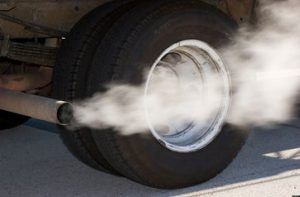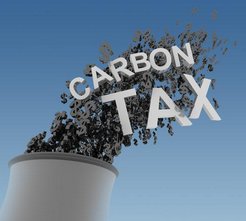by Jon LeSage, editor and publisher, Green Auto Market
Here’s my take on the 10 most significant and interesting occurrences during the past week…….
 Phase 2 of commercial truck rules: A long-awaited ruling on medium- and heavy-duty trucks on greenhouse-gas emissions and fuel economy has been released by federal agencies. The US Environmental Protection Agency (EPA) and National Highway Traffic Safety Administration (NHTSA) are proposing emissions and fuel economy improve by up to 24% through 2027, and federal efficiency standards for new trailers have been included for the first time. The proposed second-phase rules on vehicle and engine standards would run from 2021 through 2027 and apply to semi-trucks, large pickup trucks and vans, and all types of buses and work trucks. Emissions and fuel consumption from heavy-duty pickups and vans will need to be reduced by 16% between the 2021 and 2027 model years, according to the federal standards. As for feedback on the ruling, American Truck Dealers voiced concern that’s been heard for years from truck makers and suppliers – about the higher costs of compliance and economic impact if prices for commercial trucks rise. Fiat Chrysler’s FCA said it “supports and commends” the coordinated approach taken by the federal agencies. NGVAmerica and its member companies commend the rule, as does CALSTART. The Consumer Federation of America released results of a survey conducted in mid-May with more than 1,000 US consumers; 71% favor increasing fuel efficiency mandates for heavy-duty truck, while 24% oppose it.
Phase 2 of commercial truck rules: A long-awaited ruling on medium- and heavy-duty trucks on greenhouse-gas emissions and fuel economy has been released by federal agencies. The US Environmental Protection Agency (EPA) and National Highway Traffic Safety Administration (NHTSA) are proposing emissions and fuel economy improve by up to 24% through 2027, and federal efficiency standards for new trailers have been included for the first time. The proposed second-phase rules on vehicle and engine standards would run from 2021 through 2027 and apply to semi-trucks, large pickup trucks and vans, and all types of buses and work trucks. Emissions and fuel consumption from heavy-duty pickups and vans will need to be reduced by 16% between the 2021 and 2027 model years, according to the federal standards. As for feedback on the ruling, American Truck Dealers voiced concern that’s been heard for years from truck makers and suppliers – about the higher costs of compliance and economic impact if prices for commercial trucks rise. Fiat Chrysler’s FCA said it “supports and commends” the coordinated approach taken by the federal agencies. NGVAmerica and its member companies commend the rule, as does CALSTART. The Consumer Federation of America released results of a survey conducted in mid-May with more than 1,000 US consumers; 71% favor increasing fuel efficiency mandates for heavy-duty truck, while 24% oppose it.- As for federal rules on light-duty passenger vehicles: The National Research Council (NRC), an 18-member committee nonprofit group that advises federal policymakers, found that the federal 54.5 mpg by 2025 model year standards are based on sound assumptions on its technological progress and costs – even if electrified transportation doesn’t hit high sales volumes. The NRC study also expressed concern over how much consumers will be willing to pay for the fuel-efficient vehicles. The report comes out during a time when automakers, environmental groups, and regulators are determining the final federal fuel economy standards from 2022 through 2025. This midterm review process was demanded by automakers before they make the investment in retooling to reach the high mpg and emissions targets.
- Fisker Karma coming back: Fisker Automotive and Technology Group will be working out of a manufacturing plant to relaunch its Karma plug-in hybrid electric vehicle in Moreno Valley, located in California’s Riverside county. Fisker will create 150 new jobs, with about 100 of them being engineers. The company is also looking into keeping a portion of its former Anaheim headquarters. Chinese owner Wanxiang Group had promised to utilize Fisker’s Delaware plant, but the future of that plant has yet to be determined.
- Watch these videos: NAFA’s past president Claude Masters and CALSTART’s Bill Van Amberg talked to Fleet Management Weekly in these video interviews about NAFA’s Sustainable Fleet Accreditation Program and hitting clean transportation targets. Masters talks about the programs being set up to provide data fleet managers need. Van Amberg says that the true role of CALSTART is to build a clean transportation technologies industry – creating jobs that, in turn, create cleaner air.
- Hyperloop competition: It’s been nearly two years since SpaceX/Tesla CEO Elon Musk sent out the Hyperloop concept – and now it’s gaining more attention and enthusiasm. The SpaceX Hyperloop Pod Competition asks entrants to design passenger vehicles for the super high-speed Hyperloop train system. It’s intended to appeal to both university students and independent engineering teams, SpaceX says. Hyperloop Technologies, an unrelated startup with proprietary technology based in downtown Los Angeles, pledged on Twitter to support student teams submitting pod designs for the competition. Hyperloop is gaining enough traction to inspire a feature in Popular Science with this intro: “Elon Musk proposed a ridiculously audacious form of transportation. Now, startups are racing to bring the Hyperloop to life.”
- Ford land-fill free in Mexico: Ford Motor Co.’s Hermosillo Stamping and Assembly Plant has earned zero waste-to-landfill status, making the automaker landfill-free at all of its Mexico manufacturing facilities. That means Ford’s Mexico plants are diverting 1.5 million pounds of landfill waste this year and going forward. This is part of a global campaign by Ford to reduce waste-to-landfill by 40% per vehicle produced from 2011 to 2016; Ford previously hit that target by reducing global per vehicle waste-to-landfill by 40% from 2007 to 2011.
- Toyota might gain more ZEV credits in California: Toyota is not getting out of the plug-in business entirely to focus instead on hydrogen fuel cell cars. Developed with the new 2016 Prius hybrid, the new Toyota Prius Plug-in Hybrid will likely have longer electric range than its 11 miles on battery only in the current version. That will probably help tip the scales a little bit more in the automaker’s favor in California. The state is loosening up on its zero emission vehicle (ZEV) credits, and Toyota will be able to gain more credits if it sells more of these models than it’s been achieving lately. The 2016 model could generate that enthusiasm and sales increase, and could be a way for other companies to meet their targets. Mazda and Subaru, for example, will fall under ZEV requirements for the first time starting in 2018 and might be interested in buying Toyota’s technology for their vehicles to meet the targets – similar to what Toyota had previously done with Tesla Motors in its RAV4 EV.
- Nevada wants to see Electric Highway: Nevada Gov. Brian Sandoval announced that five new electric vehicle chargers will be placed on highway US 95 in between Reno and Las Vegas; that will go with the 150 charging stations already in place in the state. State officials are working with Tesla Motors to set up additional fast chargers, Tesla Superchargers, along the Nevada Electric Highway. That’ likely to happen given that Nevada will soon be home to Tesla’s Gigafactory lithium-ion battery plant near Reno.
- Biofuels get mixed message in Washington: Fans of biofuels got some “good news/bad news” out of Washington, DC. Last week, Bill Cassidy (R-La.) introduced a bill that would completely recall the federal Renewable Fuel Standard, with its ethanol and biodiesel blends and advanced biofuels provisions. Sens. Dianne Feinstein (D-Calif.) and Pat Toomey (R-Pa.) have made several attempts to remove the ethanol blend mandate, but leave in other biofuels, such as biodiesel. For those in the biofuels business needing funding, the federal government now is offering $100 million in grants under the Biofuels Infrastructure Partnership (BIP). That funding has been made available to support the infrastructure needed to make more renewable fuel options available to consumers. It will be administered by the Farm Service Agency; but those interested need to move fast – applications must be submitted by July 15, 2015.
- Continental wants to win electrified turbocharger market: Tier 1 automotive supplier giant Continental AG is throwing down the gauntlet to compete with Valeo SA, BorgWarner, and Honeywell. Similar to Valeo’s 48-volt electric motor that will soon power a new Audi vehicle, Continental is working on an electric motor to pressurize a turbocharger that will eliminate what’s called “turbo lag.” Besides bringing more power, the electrified turbocharger improves fuel economy. BMW already uses Continental turbochargers on its BMW i8 and Mini Cooper.


